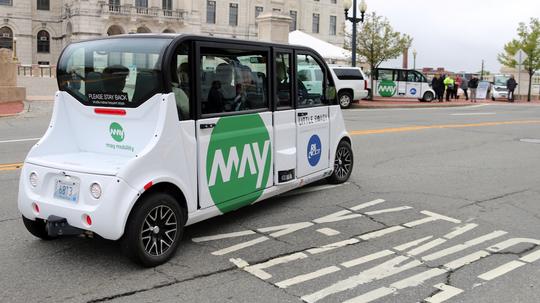
There are many different modes of transportation throughout the Woonasquatucket River Corridor — trains, buses, taxis and bike lanes.
Now add autonomous vehicles to the list.
The Rhode Island Department of Transportation last month unveiled the Little Roady Autonomous Vehicle Pilot Project, a fleet of self-driving electric vehicles that offer free rides along a 5.3-mile route, with 12 stops between Providence Station and Olneyville Square.
The shuttles are provided and operated by May Mobility, which entered into a public-private partnership with RIDOT following a competitive RFP process in April of 2018. The project is also in partnership with the City of Providence, the Quonset Development Corporation and the Rhode Island Public Transit Authority.
“We identified that connected and autonomous technologies for our transportation sector has some of the best potential to improve the system both from a safety and mobility standpoint, and is also some of the most complex technology being developed in terms of public policy and urban- and land-use planning,” Julia Gold, chief of sustainability and innovation at RIDOT, told Rhode Island Inno. “Obviously, a lot needs to be learned and discussed and integrated into many different sectors that touch the transportation industry whether its insurance companies or the DMV and so we saw an opportunity to provide real-life experience for Rhode Islanders, communities and all of the stakeholders and policy makers so they can be informed by the experience.”
The project is the longest free public transportation route in the country, according to Gold, and goes through public roads in commercial and residential areas that have speed limits up to 25 miles-per-hour, and heavy traffic at rush hour.
The corridor also has one-way roads with two lanes and then goes through the busy Olneyville Square, which can get quite congested.
“It gives us some really good real-life scenarios driving through a lot of traffic and pedestrians and bike lanes and intersecting with a bus route and a taxi stand,” said Gold. “It gives us a lot of insight into how the technologies will do well and also struggle in certain areas.”
Furthermore, the route provides a real public transportation need for working families and others in the area, who otherwise might have had to use ride-hailing apps such as Uber to get between certain points within the route.
The shuttles were getting about 100 riders per day and had transported 2,500 riders through the first three weeks, according to Charles St. Martin, chief of public affairs at RIDOT.
The project launched May 15 and will go for at least a year.
There will be a thorough assessment about three-quarters of the way through the first year, and RIDOT has the option to potentially extend the Little Roady Autonomous Vehicle Pilot Project for up to two additional years.
“Autonomous vehicles have the potential to really dramatically change our transportation system,” said Gold. “Those changes are going to take time. It’s not going to happen overnight. The kind of policy work and planning work that is required to ensure a smooth and beneficial process for communities will require many years of planning and preparation, and so we see this project as a way to really get in early and ensure smooth integration.”








